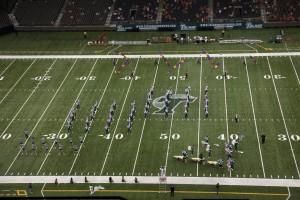No headline provided

March 2, 2012
It hasn’t been easy to support Tulane athletics recently, and members of the Tulane University Marching Band know better than most.
Tulane only recently revived the marching band program in 2005 under the tutelage of Director Barry Spanier, after a decades-long hiatus going back to the ’70s. The Soundwave pep band was established in 1992 and was largely student-run, aided by community volunteers.
Assistant Director Mark Lighthiser said he believes that a marching band is an integral part of a school’s game-day identity.
“That’s their role: to be the catalyst for school spirit, to be the people the people that are cheering through every down, to be that example for what should be happening at any school,” Lighthiser said. “I think they’re an extremely important thing for a program to have.”
Sophomore band member Chris Willuhn, who plays the mellophone, emphasized the importance of exhorting the fans present at football games and channeling energy in the stands.
“The primary role of the Tulane marching band is to support the football team in every game and to encourage fans to do the same, regardless of the score or the team’s record,” Willuhn said. “It plays a key role bridging the gap between the student body and the football team, while also attempting to bring energy to the fans.”
The two flagship programs of any athletic program – football and men’s basketball – have languished as Conference USA members. On the hardwood, the Green Wave finished last in C-USA in 2011, while finishing second-to-last in 2010 – combining for nine conference wins from the past three seasons, including this year.
Football has performed even worse. The squad has won a whopping total of five league games, accumulating 27 losses, while finishing last or tied for last place in C-USA twice in the past four seasons. The other two years, 2008 and 2010, the Wave finished as the conference’s second-worst team.
Even baseball and women’s basketball, two sports Tulane has traditionally excelled in, have been shells of their former selves in recent years. Women’s hoops struggled to with high expectations in 2010-11 after reaching the 2010 NCAA Tournament, and baseball has failed to reach the postseason in the last four years.
As one of the band’s leaders, Lighthiser acknowledged the difficulty of supporting an athletic program that has had a dearth of on-field or on-court success, especially Saturday afternoons with the Green Wave football team.
“Realistically, yes, there is an effect, but I think philosophically, there shouldn’t be,” Lighthiser said. “You shouldn’t have to have that external motivation to have personal excellence. I try to teach that to students that we have. That said, yeah, it’s hard to be the only ones in the Superdome, cheering when we’re losing, when we have eight losses.”
Willuhn also said he thinks that the challenge of maintaining a spirited atmosphere wears on the rest of the marching band.
“From an individual perspective, it’s a lot more difficult to find motivation to go to the games and perform at 100 percent when you know the team is going to lose regardless of your efforts,” Willuhn said. “It gets demoralizing very quickly, particularly when you lose 10 games in a row.”
Lighthiser also believes that the culture of instant gratification is one reason that keeps more Tulane students from attending sports games and that people too often expect immediate results or quick fixes.
“I think putting all that emphasis on winning is one of the challenges or problems with the current college sports atmosphere,” Lighthiser said. “You shouldn’t have to have a 10-win season every season to have fans come out and see you and people come support your program.”
The taint of losing and mediocrity is tough at times for the marching band, because student support often falls dramatically after the first or second football game of the season.
“It’s difficult,” Lighthiser said. “I did it. We do it all the time. To say that cheering for a losing team is just as easy as cheering for a winning team is not true, but that doesn’t mean we shouldn’t do it. I think there’s a culture gap, that part of there not being a band here, and tearing down Tulane Stadium… I think there was a big vacuum for spirit when it came to Tulane football.”
Building the new stadium and investing in the new coach, Lighthiser said, will help fill that hole and get students more involved – which will in turn help the marching band’s mission of bringing about more pride in Tulane as a university.
Lighthiser pointed out the importance of the band’s goal to be a group of students who stands throughout a game, cheering every play and playing the fight song as often as possible.
“That’s the kind of support that the team needs to be successful on the field, and without that, it’s really hard,” Lighthiser said.
Lighthiser identified the lack of a music education program as a source of challenges for Tulane’s marching band. At many other schools, the two programs feed off each other. The band has had 73 to 75 members during the past two years and hopes to sustain 100 members annually within five years. Between 25 and 30 freshmen usually begin with the band, but upperclassmen retention has been difficult because of limited music programs, study abroad and other factors.
Willuhn, in a way, implied the key to fostering dedicated students who have pride in Tulane athletics may lie in the efforts of the marching band.
“There are very few organizations on campus that bring such a diverse, intelligent and dedicated group,” Willuhn said. “Some of them are the best friends I’ve made since coming to Tulane, and every single one of them supports Tulane athletics as much as any other student on campus.”









Leave a Comment